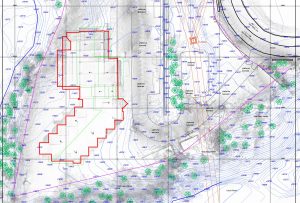Handheld scanners are built for usability, portability and speed and use Simultaneous Locating and Mapping (SLAM) lidar to scan while being held and walked around a jobsite. There are some clear advantages that manual scanning can bring to construction that can make 3D scanning even more cost-effective.
YOU CAN SCAN AS FAST AS YOU CAN GO.
Traditional tripod-based scanners require a stop-start workflow that involves alternating periods of set-up, scanning, disposal and transport to the next scanning position. Besides being tedious, the time required between each scanning point is time that could be spent doing other work on a site.
Instead of spending most of their time not scanning, SLAM handheld scanners allow workers to scan continuously as they go. Walking while scanning is an obvious time saver, but it can even provide a less tedious and more comfortable scanning task, making it something employees want to do rather than dread.
GET MORE INFORMATION IN MUCH LESS TIME
The portable lidar workflow at a building complex, for example, is several times faster than traditional static (tripod) scanning, and it also requires only one user. When comparing costs, the handheld scanner will also come out cheaper.
MAKE PHOTOS AND CLOUDS OF DOTS TOGETHER
Some handheld lidar scanners include a built-in camera to simultaneously capture colour images while a scan is taking place. This saves the step of capturing images separately with an external camera and doesn’t require extra time.
The end result of a 3D scan is a coloured point cloud – a combination of lidar points and colour image. Images are also available for viewing on their own, to help identify and model elements in the capture or simply as a quick way to look back at a particular location.
ENTER SMALLER SPACES
On a construction site, it is unlikely that the site will always be wide open and have uncomplicated spaces that need to be captured. What is more likely is that contractors find they are accessing complex structures, tight spaces or other geometries that would prohibit or inhibit the use of traditional scanning platforms. Instead of omitting those small, complex spaces, mobile scanning allows for a more complete capture of a site.
With a handheld scanner, the footprint is much smaller, allowing it to fit where others can’t. The long pole of the handheld scanner can even be used to scan in places where a large person might not be able to squeeze through.
No approval by the aviation authority is required
While drones are becoming increasingly useful in construction, they’re not always the best fit for certain job sites. While drones are great for outdoor viewing, it can be difficult to deploy them successfully and safely indoors. Combined with ever-changing drone regulations, the use of drones in construction is often not preferable. However, adding a handheld scanner to the toolkit can more than make up for places where drones can’t go and no one needs aviation authority approval.
People in the way? No problem!
Construction jobs are active, and people move from one area to another depending on their tasks for the day. Waiting for a particular section to become empty for scanning or scanning after hours (with employees accumulating overtime) can be costly. Even asking a group of people to leave an area is disruptive and can slow progress. However, handheld scanners can work around people and still capture good data. As you scan, if people are relatively still for a minute or two as you pass, the device will still capture the full scene.
GET ANYONE TO SCAN WITH MINIMAL TRAINING
Performing a scan with a handheld scanner has a much lower learning curve than a traditional scanner and requires much less training and expertise to operate. This can allow the task of scanning a site to be distributed to available workers, rather than downgraded to a single on-site expert.
A basic workflow involves turning on the scanner, inserting it into a holster or harness, and then walking around the asset or site. The attached tablet display can be used to stop scanning after completing the route, and then the scanner will process the data. The attached displays even provide feedback as the scan is captured, so anyone using the scanner can capture professional scans.



